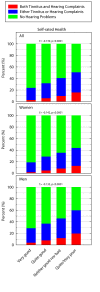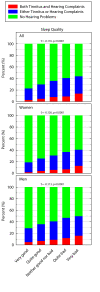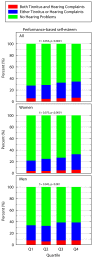Stress and prevalence of hearing problems in the Swedish working population
- PMID: 21345187
- PMCID: PMC3056746
- DOI: 10.1186/1471-2458-11-130
Stress and prevalence of hearing problems in the Swedish working population
Abstract
Background: Current human and experimental studies are indicating an association between stress and hearing problems; however potential risk factors have not been established. Hearing problems are projected to become among the top ten disabilities according to the WHO in the near future. Therefore a better understanding of the relationships between stress and hearing is warranted. Here we describe the prevalence of two common hearing problems, i.e. hearing complaints and tinnitus, in relation to different work-and health-related stressors.
Methods: A total of 18,734 individuals were invited to participate in the study, out of which 9,756 (52%) enrolled.
Results: The results demonstrate a clear and mostly linear relationship between higher prevalence of hearing problems (tinnitus or hearing loss or both) and different stressors, e.g. occupational, poorer self-rated health, long-term illness, poorer sleep quality, and higher burnout scores.
Conclusions: The present study unambiguously demonstrates associations between hearing problems and various stressors that have not been previously described for the auditory system. These findings will open new avenues for future investigations.
Figures





References
-
- Mathers C, Smith A, Concha M. Global Burden of Disease. Geneva: World Health Organization; 2000. Global burden of hearing loss in the year 2000; pp. 1–30.
Publication types
MeSH terms
LinkOut - more resources
Full Text Sources
Medical

